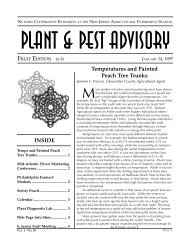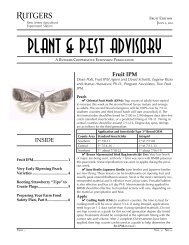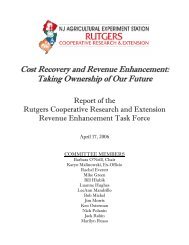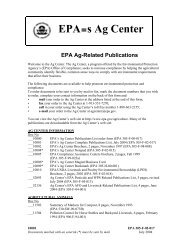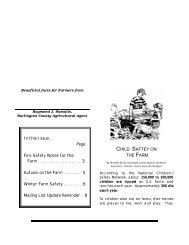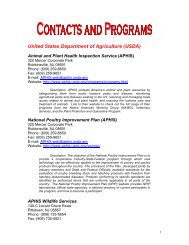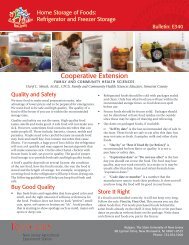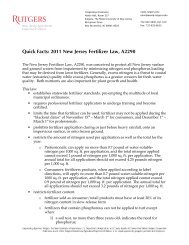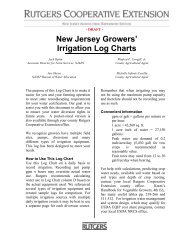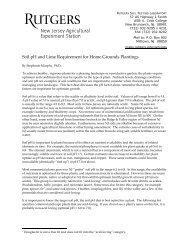INSIDE Bacterial Leaf Scorch of Oak - Rutgers New Jersey ...
INSIDE Bacterial Leaf Scorch of Oak - Rutgers New Jersey ...
INSIDE Bacterial Leaf Scorch of Oak - Rutgers New Jersey ...
You also want an ePaper? Increase the reach of your titles
YUMPU automatically turns print PDFs into web optimized ePapers that Google loves.
Diseases <strong>of</strong> Turfgrass<br />
Bruce B. Clarke, Ph.D., Specialist in Turfgrass<br />
Pathology<br />
General<br />
Dollar spot has redeveloped on golf and landscape<br />
turf due to the recent cool, wet weather (August 18-23,<br />
2007). Expect this disease to continue to be a problem<br />
through October. Copper spot, summer patch, fairy<br />
ring, slime mold and anthracnose are also active at this<br />
time. Pythium and brown patch can still be troublesome<br />
if the hot, humid weather returns so maintain<br />
preventive sprays. Refer to recent issues <strong>of</strong> this newsletter<br />
for further disease control information.<br />
Gray <strong>Leaf</strong> Spot<br />
Gray leaf spot, caused by the fungus Pyricularia<br />
oryzae, is really starting to intensify on susceptible<br />
perennial ryegrass overseedings. This disease has<br />
devastated many new perennial ryegrass and tall fescue<br />
plantings throughout the Mid-Atlantic States over the<br />
past few years. Symptoms start as tiny, brown leaf<br />
and stem lesions within a 1 to 2 inch patch. In severe<br />
cases, the leaves twist and curl in a “J-shape” and lesions<br />
may extend the entire width <strong>of</strong> the blade. As the<br />
disease progresses, patches coalesce into large (1 to 2 ft<br />
diameter) areas <strong>of</strong> blighted turf. Extensive foliar blighting<br />
may occur during warm (70-85 0 F days and 60-75 o<br />
F nights), wet weather. <strong>New</strong>ly established seedings are<br />
more susceptible to infection than mature plantings, so<br />
be sure to use a mixture <strong>of</strong> perennial ryegrass cultivars<br />
with improved resistance to Gray <strong>Leaf</strong> Spot (e.g., 1G 2 ,<br />
1G2, All*Star 3, Apple GL, Charismatic II GLSR, Dart,<br />
Derby Xtreme, DP-1, (Soprano) Exacta II GLSR, Fiesta<br />
4, GL-2, Harrier, Manhattan 5 GLR, Palace, Palmer<br />
IV, Palmer GLS, Palmer V, Panther GLS, Paragon GLR,<br />
Prelude GLS, Primary, Protégé GLR, Regala 5, Repel<br />
GLS, Revenge GLX, Secretariat II GLSR, SR 4600, and<br />
Stellar GL) when overseeding or establishing new areas.<br />
When conditions are conducive to disease development<br />
the pathogen produces abundant one to two-celled,<br />
pear-shaped spores (conidia). To suppress this disease,<br />
avoid high rates <strong>of</strong> nitrogen (i.e., do not apply more<br />
than 0.25 lb N per 1,000 sq ft) during July and August<br />
and avoid extended periods <strong>of</strong> leaf wetness (i.e., do not<br />
water between 6 PM and midnight). Fungicide studies<br />
have shown that Armada, Compass, ConSyst, Disarm,<br />
Headway, Heritage, Insignia, Spectro, Tartan, and thiophanate-methyl<br />
have been most effective when applied<br />
on a preventive basis every 14 to 28 days from mid-July<br />
to late-September. Chlorothalonil (e.g., Daconil) and<br />
the DMI (sterol-inhibiting) fungicides (e.g., Banner or<br />
Bayleton) may provide effective control when disease<br />
pressure is moderate. Isolates <strong>of</strong> P. oryzae resistant to<br />
the QoI (Strobilurin) fungicides and strains with reduced<br />
sensitivity to the DMI’s have been reported in <strong>New</strong><br />
<strong>Jersey</strong>, so alternate fungicide chemistries whenever possible<br />
to reduce the potential for fungicide resistance.<br />
Marasmius<br />
There have been numerous reports recently about<br />
the appearance <strong>of</strong> small mushrooms protruding from<br />
brown leaf blades. These structures, belonging to the<br />
fungus Marasmius, are approximately ½ to ¾ inch in<br />
length, and consist <strong>of</strong> a dark brown stem and a small<br />
tan to orange colored cap. Marasmius <strong>of</strong>ten appears in<br />
areas that have been thinned by brown patch. Although<br />
this fungus may appear to be pathogenic, it is actually<br />
invading dead and dying tissue and thus is not a threat<br />
to the surrounding turf.<br />
<strong>New</strong>s Release: Dollar Spot Samples Needed<br />
Ms. Jo Anne Crouch, a doctoral student working<br />
with Dr. Bruce Clarke (Extension Specialist in Turfgrass<br />
Pathology), is collecting samples <strong>of</strong> turf infested with<br />
dollar spot. The purpose <strong>of</strong> this research is to confirm<br />
the “true” identity <strong>of</strong> the dollar spot fungus and to determine<br />
the geographic origin <strong>of</strong> this aggressive pathogen.<br />
Turf samples are being requested from all regions <strong>of</strong> the<br />
United States as well as from other countries throughout<br />
the world. Your help is needed to help get this project<br />
underway!<br />
If you encounter dollar spot during the next few<br />
months, please send a sample <strong>of</strong> the infested turf to Rich<br />
Buckley at the <strong>Rutgers</strong> Plant Diagnostic Laboratory:<br />
U.S. POSTAL SERVICE only:<br />
Plant Diagnostic Laboratory<br />
<strong>Rutgers</strong>, The State University <strong>of</strong> <strong>New</strong> <strong>Jersey</strong><br />
PO Box 550<br />
Milltown, NJ 08850-0550<br />
OTHER DELIVERY SERVICES:<br />
Plant Diagnostic Laboratory<br />
<strong>Rutgers</strong>, The State University <strong>of</strong> <strong>New</strong> <strong>Jersey</strong><br />
Ralph Geiger Turfgrass Education Center<br />
20 Indyk-Engel Way<br />
North Brunswick, NJ 08902<br />
Telephone: 732-932-9140<br />
FAX: 732-932-1270<br />
E-mail: clinic@rcre.rutgers.edu<br />
Website: www.rcre.rutgers.edu/plantdiagnosticlab<br />
Be sure to indicate the type <strong>of</strong> turf infested, the<br />
location where the sample was taken, and your contact<br />
information. If you should have any questions please<br />
contact Jo Anne Crouch at jcrouch@eden.rutgers.edu<br />
((732) 932-9375 x 334) or Bruce Clarke at Clarke@<br />
aesop.rutgers.edu. (x 331). o<br />
Page Vol. 3 No. 2



